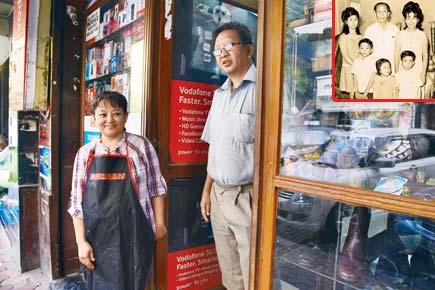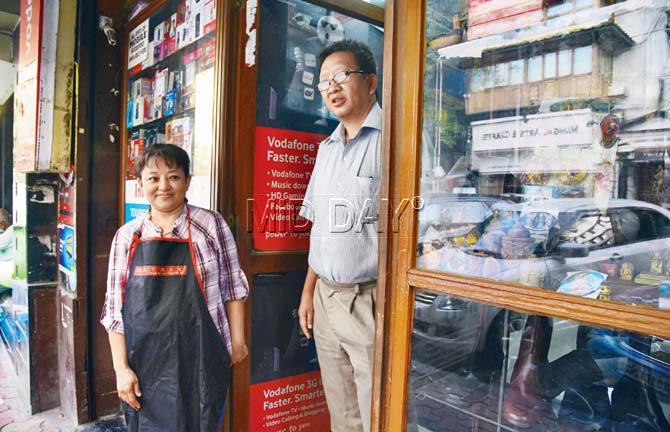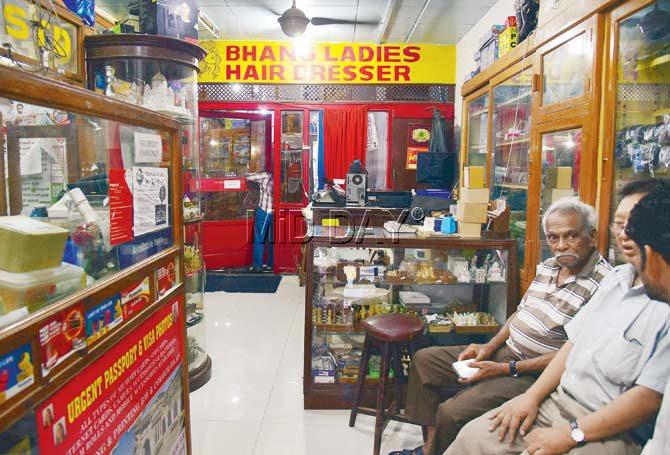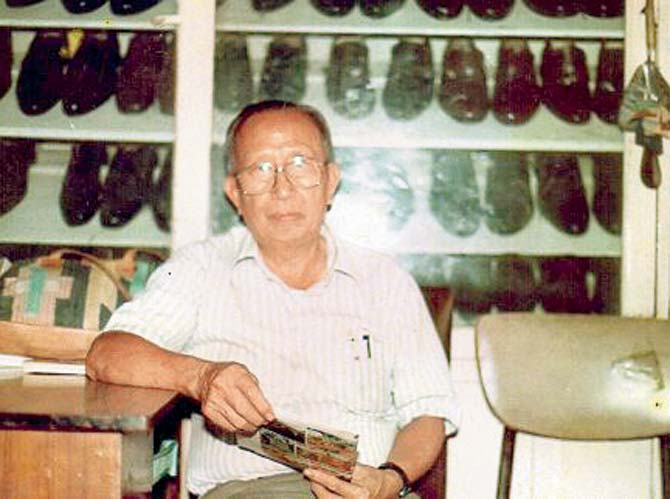The third generation of the Bhangs, a Chinese family that found its home in Mumbai after migrating from Guangdong, talks of its journey from being Bollywood’s go-to shoe makers in the 1980s to hairstylists in the new millennium

George Bhang, 55, and his wife Glenda, 50, have split the management of the 85-year-old S. Bhang & Co. between themselves. While George handles the souvenir store, Glenda takes care of the ladies parlour, which was started over 45 years ago
ADVERTISEMENT
It takes some assiduous searching to locate this almost indiscernible shop in the lane that cuts open at Cafe Mondegar in Colaba. Until some years ago, the iconic restaurant was the only landmark for curious customers seeking out this place. Today, a patisserie and a funky pub are new additions.

George Bhang, 55, and his wife Glenda, 50, have split the management of the 85-year-old S. Bhang & Co. between themselves. While George handles the souvenir store, Glenda takes care of the ladies parlour, which was started over 45 years ago. Pic/Atul Kamble
In the last eight decades, the landscape around this store has changed devastatingly, yet, S Bhang & Company, which hides behind the flailing barks of a tree, remains unchanged in appearance.

With the coming in of cheaper brands in the 1990s, the demand for Chinese shoemakers in Mumbai started fading. Around this time, George’s aunt’s ladies’ parlour, which opened in 1970, helped keep business afloat. Pic/Atul Kamble
A yellow-coated derelict wooden board that nervously hangs on one side of the shop reads, Bhang Ladies Hairdresser. But, if you’re a first-time client at this salon, the façade of this store is most likely to mislead. On one side of the large glass window are leather shoes that have rested here for eons, and on the other, marble and wooden souvenirs. Fliers of bus fares to Goa and mobile recharge packages are other businesses that take up space on the front door. All of this might appear like a trunk of an enterprise for this small shop. But, 55-year-old Chinese immigrant George Bhang, who is the last man standing at S. Bhang & Co., a patron-driven 85-year-old business that has fluctuated through immense highs and lows, these are a few attempts at ensuring that the brand created by his grandfather Akew Peng and later, fashioned by his father Charlie, outlives him.
Today, George and his wife Glenda — also a Chinese descendant who hails from the Northeast of India — have split the task of taking the family’s legacy forward, managing the souvenir store and ladies’ parlour, respectively.

Some of the shoes Charlie Bhang (above) made during his lifetime have now been encased in glass shelves and displayed at the souvenir shop
In its heyday, it was the dugout of the who’s who of Bollywood, recalls George. There’s nothing in the store to give away stories of its prime, until he points to the shoe-racks. “My father was a shoemaker,” he tells us. “The Chinese in India have always been known for two things, their eateries and footwear,” he adds. His family was equipped with both.

In an undated family photo, Charlie, whose real name is Pan Su Leh, is seen with wife Laichen Yun (right), a family member, and his three children, George (left), Christina and John
When the Bhangs first moved to Bombay from Calcutta in the early 1930s, they opened a Chinese restaurant at this same spot. The lack of customers led George’s grandfather Peng to switch businesses. The shoemaking skills that Peng acquired while working for a tannery in Calcutta salvaged the Bhangs’ sinking brand, and they opened a shoemaking store and workshop here, a few years later. His 12-year-old son Pan Su Leh, christened Charlie, hopped onto the trade in the 1940s. He would turn around the family’s fortunes forever.
Shoes for a stellar cast
There was a time when neither Charlie nor his son George knew Hindi. And, the Indian film industry was almost foreign to the Bhangs, who originally hail from the Guangdong province of South China. “We only watched English movies,” recalls George.
When famed costume designer Bhanu Athaiya, who had dressed the likes of Shammi Kapoor and Guru Dutt, strolled into the family’s shoe store one day, George — still a teenager at that time — says his father wouldn’t have guessed, who had just walked in and why. Athaiya was looking for an ingenious shoemaker to make her the finest pairs of vintage shoes for a project that was not only dear to her, but also her biggest to date.
The film was Richard Attenborough’s Gandhi (1982), coincidentally, a Hollywood film, starring Ben Kingsley in the lead. By then, Charlie was nearly four decades old in the shoemaking industry. “And competition was stiff,” says his son. “There were more than six to seven Chinese shoemaking greats in South Mumbai itself, including Lee & Co. that made shoes for the viceroys of India, and Lee Yansen & Co, popularised by Agha Khan, who got them to make him shoes of gold,” says George.
In the midst of such a distinguished lot, his father’s business seemed rather modest, despite doing reasonably well. But, with Athaiya coming into the picture, the tables quickly turned. The two would go on to work on several films together, some of which George, who is still not very tuned to Bollywood, can’t call to mind. It’s also likely that Athaiya and Charlie’s association started way before Gandhi, but George isn’t sure.
But, he remembers the 1983 film Razia Sultan because of “the number of similar looking pairs of shoes my father made for Hema Malini”. “The movie was shot in Moscow, and she was expected to wear the shoes for the entire shoot,” says George.
Bollywood’s ‘Dream Girl’ though, was extremely particular about her shoes not getting soiled. A slight wear and tear, and a new pair would be called for. “My father ended up making 10 pairs of the same shoes. I still remember him sitting overnight to get them done for her each time. The next morning an assistant would collect the pair and courier it to Moscow,” he says.
The Bhangs started selling their shoes at R8 a pair in the 1930s; by the 1980s, the prices skyrocketed to Rs 300 and above, depending on the leather and style. “And the making of each pair, right from design to construction, would at least take a week,” says George.
With Charlie's growing popularity in the film industry circle, a star would occasionally pop in and make acquaintance, or send their staff with measurements, to get leather boots or sandals made. “My father taught Athaiya, how to take foot measurements,” he informs. Before they knew, Dharmendra, Rekha, Dilip Kumar and Saira Banu, Shashi Kapoor and his son Karan, had become regular customers.
Changing history
Despite winning favour with the stars, Charlie was aware that his business wouldn’t survive the test of time. In the ’90s, two of his three children migrated to Canada, like most members of the Chinese community. In fact, the Chinese, first began moving after the Indo-Chinese war in 1962, when they lost their jobs at the naval docks, George says.
George decided to stay back with his parents, because he suffered from Leber congenital amaurosis, a rare inherited, degenerative eye disorder, which causes visual impairment. “Though I knew how shoes were constructed, my poor vision didn’t allow me to pursue the skill,” says George, whose real name is Pang Li Hua.
In the ’80s, Charlie opened a small souvenir shop inside the shoe store for his son. The workshop had already been converted into a ladies’ parlour in 1970, and was being run by Charlie’s sister. “We had two to three workshops in the area, and my father hired full-time labourers,” he says.
Meanwhile, with the coming in of cheaper brands, Chinese shoemaking stores in South Mumbai began disappearing slowly. Today, there are none. George’s father held on to the trade till 2000. When he died at the age of 86 in 2011, George, who is the eldest son, decided to give him a fitting tribute. Some of the shoes which he had made during his lifetime, were encased in the glass shelves and are now displayed at S Bhang & Co’s souvenir shop. “They aren’t on sale. We just get them out once in a while, and have them polished.” Now, most customers, who drop by are for Glenda, who honed her hair snipping skills from George’s aunty.
George was still indulging us in his nostalgic journey, when an 86-year-old Parsi woman, who walked out of Glenda’s salon after a hair trim, eavesdropped into our conversation. She informs us that she got her first-ever pair of heel shoes made at this store, back in 1943. “I have really large feet. Size 10,” said the woman, who did not wish to be named. “The Bhangs made it possible for me to flaunt great shoes.” These days, it’s the hair. Noneth-eless, they have her covered.
 Subscribe today by clicking the link and stay updated with the latest news!" Click here!
Subscribe today by clicking the link and stay updated with the latest news!" Click here!







